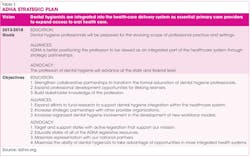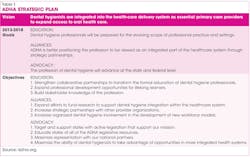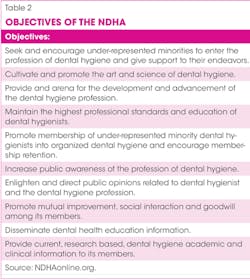Celebrate National Dental Hygiene Month
BY JOANN R. GURENLIAN, RDH, PhD
October is National Dental Hygiene Month, and this is the time of year when we can be proud of our chosen profession and the impact we have on improving the health of the public. Certainly, there are numerous opportunities to participate in local and state initiatives to promote dental hygienists as primary care providers and influencers of change during this month. The "Days on the Hill," continuing education programs, state meetings, and countless volunteer projects create awareness about the value of dental hygienists.
One area that strikes me as important during this time of celebration is recognizing the power of membership in our professional associations. We have two dynamic national organizations leading the profession forward: the American Dental Hygienists' Association (ADHA) and the National Dental Hygienists' Association (NDHA).
The ADHA was formed in 1923 with the original intent to develop a mechanism for dental hygienists to communicate and cooperate. "To improve the public's total health, the mission of ADHA is to advance the art and science of dental hygiene. We work to:
• "Ensure access to quality oral health care.
• "Increase awareness of the cost-effective benefits of prevention.
• "Promote the highest standards of dental hygiene education, licensure, practice, and research.
• "Represent and promote the interests of dental hygienists."1
ADHA has established a five-year strategic plan. The vision statement, goals, and objectives of this plan appear in Table 1.
The NDHA was founded in 1932 with the purpose of addressing special problems of the minority hygienist. Today, membership spans the United States, Canada, and the Caribbean. The mission of the NDHA is to:
• "Promote the highest educational and ethical standards for dental hygienists. Create definite position statements on issues impacting the profession of dental hygiene.
• "Enhance recruitment efforts for minority students' communities in need.
• "Assist in the access to oral care for the under-served communities in the United States.
• "Improve the association's visibility via public service.
• "Provide a professional foundation for minority dental hygienists.
• "Increase the number of minority dental hygienists."2
Table 2 highlights the objectives of the NDHA.
My goal in sharing information about these two national professional organizations is to help you see the level of involvement of these organizations and how they are working to advance the profession, expand the scope of practice, increase career options, maintain high standards, and encourage a connection among our colleagues.
If it has been awhile since you were a member of the ADHA or NDHA (or both), now is the time to get reacquainted with them and what they offer you as an individual as well as the profession. If you are already a member, be proud of what you are doing to support these organizations for they cannot realize their goals without you. Each of us brings value to our professional association just as the organization gives us worth. We serve as a resource to and for each other.
As you celebrate dental hygiene month, take the time to recognize the value of your professional associations. For more information about the ADHA, visit adha.org. For more information about the NDHA, visit NDHAonline.org. RDH
References
1. ADHA. About ADHA. Mission & History. Available at http://www.adha.org/mission-history. Accessed July 29, 2015.
2. National Dental Hygienists' Association. Mission. Available at http://www.NDHAonline.org. Accessed July 29, 2015.
JOANN R. GURENLIAN, RDH, PhD, is president of Gurenlian & Associates, and provides consulting services and continuing education programs to health-care providers. She is a professor and dental hygiene graduate program director at Idaho State University, and president of the International Federation of Dental Hygienists.


